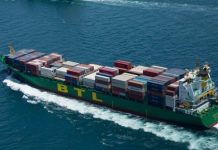
With the Chinese New Year over and liner operators adjusting their operations to accommodate the diversions round the Cape of Good Hope, rates have peaked and are likely to face downward pressure until the next pick-up in the third quarter, according to the Baltic Exchange’s report.
Freightos’ research lead, Judah Levine, one of the report’s writers, noted that rates from Asia to North Europe and the Mediterranean declined throughout February. North Europe rates decreased by 17% to US$4,553/FEU and Mediterranean prices eased by 19% to US$5,224/FEU, although each remained nearly triple their levels in February 2019.
Tonnage has been held up by the threat of attacks by Houthi rebels in the Red Sea, causing liner operators to reroute ships round the Cape.
Prices for Asia-North America containers slowed their ascent but continued to climb for much of February nonetheless. Rates to the US East Coast increased by 9% to US$6,709/FEU and Asia-US West Coast prices climbed 17% to US$4,809/FEU as some demand may be shifting to the West Coast to avoid diversion impacts.
Rates to each coast, however, decreased slightly late in the month, suggesting that prices on these lanes are past their peak.
Additionally, transatlantic rates – which had not climbed in December 2023 and January 2024 – increased by 59% in February to US$1,862/FEU.
Levine wrote, “However, carriers may not be expecting diversions and market conditions to allow rates to climb much more as some are postponing additional planned surcharges. Cooling demand and improving operations will likely continue to ease pressure on rates into March. While prices should nonetheless remain above normal levels as long as diversions continue and carriers pass on higher costs, some shipper groups estimate that current rates are significantly outstripping cost increases. This assessment – taken alongside continued capacity growth via newbuild deliveries – further points to the likelihood that prices will continue to come down from the highs seen in January and February.”
Vespucci Maritime’s founding CEO Lars Jensen wrote that concerns about vessel and container availability have proved unfounded.
Jensen noted that liner operators have not pulled ships out of the Transpacific lanes to be inserted into Asia-Europe and Asia-Mediterranean trades, meaning there is sufficient tonnage for the latter lanes.
Jensen wrote, “Networks have now stabilised in their new round-Africa loops. The initial disruptions on both vessel and equipment availability have by now been largely sorted out. Naturally, the diversions do soak up a substantial amount of capacity, but not so much as to lead to any severe lack of capacity.”
That said, the increasing seriousness of the latest Houthi attacks means that mainstream operators are unlikely to resume Red Sea transits anytime soon.
Jensen noted, “Some reduction of capacity operated into the Gulf of Aden might be expected. This will, in particular, impact services to and from Ethiopia.”
Martina Li
Asia Correspondent





